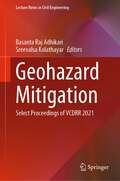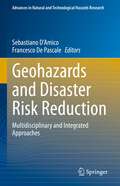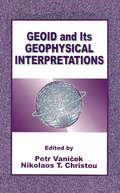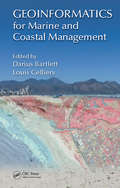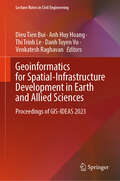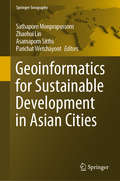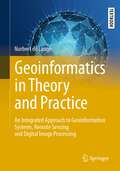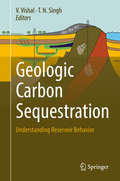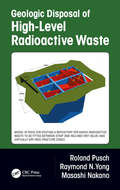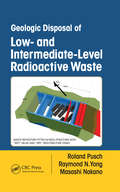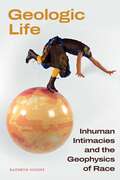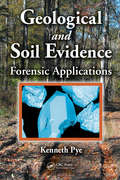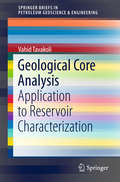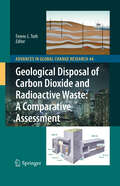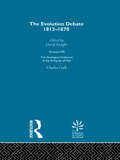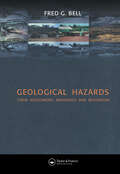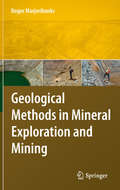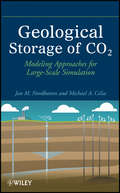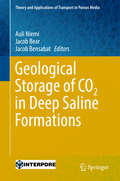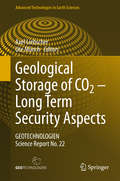- Table View
- List View
Geography Tools and Concepts
by Heidi Hayes Jacobs Brenda Randolph Michal L LevasseurIncludes: A hands-on, active approach to practicing and applying key social studies skills, Engaging, step-by-step activities for exploring important topics in geography, High-interest selections by authors that help geographic concepts come to life.
Geohazard Mitigation: Select Proceedings of VCDRR 2021 (Lecture Notes in Civil Engineering #192)
by Basanta Raj Adhikari Sreevalsa KolathayarThis book presents the select proceedings of the Virtual Conference on Disaster Risk Reduction (VCDRR 2021). It emphasizes on the role of civil engineering for a disaster resilient society. It presents latest research in geohazards and their mitigation. Various topics covered in this book are land use, ground response, liquefaction, and disaster mitigation techniques. This book is a comprehensive volume on disaster risk reduction (DRR) and its management for a sustainable built environment. This book will be useful for the students, researchers, policy makers and professionals working in the area of civil engineering, especially disaster management.
Geohazards and Disaster Risk Reduction: Multidisciplinary and Integrated Approaches (Advances in Natural and Technological Hazards Research #51)
by Sebastiano D’Amico Francesco De PascaleThis book provides a comprehensive and multidisciplinary approach to addressing geohazards, with topics such as social vulnerability reduction, risk prevention, institutional preparedness, and community resilience. It also introduces new technologies to study geohazards, which is important since geohazards have caused many casualties, economic losses, and damage to cultural heritage throughout human history. Despite this, the culture of risk prevention is not yet widespread, so Disaster Risk Reduction activities must focus on increasing capacities, strategies, and action plans for prevention and preparedness in local communities.
Geoheritage of the Middle Atlas (Geoheritage, Geoparks and Geotourism)
by Khaoula BaadiThis book is a condensed summary of a broad spectrum of the geological heritage of the Middle Atlas. It has the particularity of proposing an in-depth synthesis and a critical review of the geoheritage of the region. The book addresses the issues related to geoheritage and methodologies for the selection, inventory, assessment and preservation of geosites. It reviews the state of the art of geoheritage in Morocco, particularly in the Middle Atlas, in order to identify geosites with rare and unique geological features. The book presents a detailed study of lithostratigraphic and sedimentological heritage as geosites witnessing at different spatial and temporal scales the evolution and the stratigraphic, sedimentological and paleogeographic history of the Middle Atlas range. It also presents the paleontological heritage of vertebrates by reviewing the discoveries of paleontological sites and their risks in order to present its conservation plans. It also addresses the hydric and fluvial heritage by presenting the potential of water resources and the impact of climate change on the latter. Furthermore, it highlights the karst heritage by exposing an inventory of exo- and endokarst geosites in order to emphasize some unique sites on a national and African scale as well as revealing the underground biodiversity related to this heritage. Finally, it proposes a presentation of the volcanic heritage in order to assess the volcanic geosites that testify to the strombolian, phreatomagmatic and Hawaiian dynamism of the region. The book is mainly intended for researchers, geologists and specialists of the Moroccan Middle Atlas region wishing to acquire a broad multidisciplinary or even transdisciplinary knowledge. It will also be accessible to a non-initiated public, interested in the richness of the Moroccan geoheritage, as well as to Moroccan territorial authorities (High Commission for Water and Forests, Ministry of Tourism, National Institute of Archaeology and Heritage Sciences, etc.) who can benefit from it in the perspective of their strategies of preservation of the national geological heritage. This work will be an example for geoscientists, on an African scale, of a valorization of territorial geological heritage.
Geoid and its Geophysical Interpretations
by Petr Vanicek Nikolaos T. ChristouGeoid and its Geophysical Interpretations explains how an accurate geoid can be constructed and used for a variety of applied and theoretical geophysical purposes. The book discusses existing techniques for geoid computation, recently developed mathematical and computational tools designed for applications, and various interpretations. Principles and results are well illustrated. This book will be an excellent reference for geodesists, geophysicists, geophysical prospectors, oceanographers, and researchers and students in geophysics and geodesy.
Geoinformatics for Marine and Coastal Management
by Darius Bartlett and Louis CelliersGeoinformatics for Marine and Coastal Management provides a timely and valuable assessment of the current state of the art geoinformatics tools and methods for the management of marine systems. This book focuses on the cutting-edge coverage of a wide spectrum of activities and topics such as GIS-based application of drainage basin analysis, contribution of ontology to marine management, geoinformatics in relation to fisheries management, hydrography, indigenous knowledge systems, and marine law enforcement. The authors present a comprehensive overview of the field of Geoinformatic Applications in Marine Management covering key issues and debates with specific case studies illustrating real-world applications of the GIS technology. This "box of tools" serves as a long-term resource for coastal zone managers, professionals, practitioners, and students alike on the management of oceans and the coastal fringe, promoting the approach of allowing sustainable and integrated use of oceans to maximize opportunities while keeping risks and hazards to a minimum.
Geoinformatics for Spatial-Infrastructure Development in Earth and Allied Sciences: Proceedings of GIS-IDEAS 2023 (Lecture Notes in Civil Engineering #411)
by Dieu Tien Bui Anh Huy Hoang Thi Trinh Le Danh Tuyen Vu Venkatesh RaghavanThis volume gathers the latest advances, innovations, and applications in the field of GIS and geo-spatial technologies, as presented by leading researchers and engineers at the International Conference on Geoinformatics for Spatial-Infrastructure Development in Earth & Allied Sciences (GIS-IDEA), held in Hanoi, Vietnam on November 7-9 2023. The contributions cover a diverse range of topics, including geoinformatics, geomatics, geospatial AI for natural hazards, Big Data and AI in sustainable natural resource management, GIS and remote sensing for natural disaster monitoring, GIS for spatial analysis, planning and management, GeoAI for building digital maps. Selected by means of a rigorous peer-review process, they will spur novel research directions and foster future multidisciplinary collaborations.
Geoinformatics for Sustainable Development in Asian Cities (Springer Geography)
by Sathaporn Monprapussorn Zhaohui Lin Asamaporn Sitthi Parichat WetchayontThis proceedings volume focuses on the importance and power of spatial thinking and planning, especially by applying geospatial technologies in solving the past and current global problems such as environmental degradation, urban pollution, climate change, agricultural management and epidemiology.The proceedings of the International Conference on Geography and Geoinformatics for Sustainable Development 2018 (ICGGS 2018) consist of a wide range of case studies from developing countries. The contributions address challenges of developing countries in mainstreaming sustainable development paradigm into their economy with the aim to improve and manage natural resources and environment in a sustainable manner. One of the main goals of the conference and the proceedings is to share and exchange different perspectives on global, regional and local spatial issues and how the concept of spatial planning and thinking can be used in building resilience to natural and anthropogenic threats in many sectors (such as water, ecosystem, agriculture and health). This includes a summary of how the key concepts of geospatial technologies could contribute to environmental sustainability and the Sustainable Development Goals (SDGs) as well as an outlook on challenges and opportunities for sustainable development. This book explains how geoinformatics can help analyse, model and explain sustainable development within a geographic context and thus provide the integrative framework necessary for global collaboration consensus and evidence-based decision-making. It highlights the vital and integrative role of geospatial information in driving sustainable development and thus can be used as a tool to put the 2030 Agenda for Sustainable Development into practice. This volume can be a useful resource for readers regarding research on geospatial issues on both the regional and local scale. Both undergraduate and graduate students around the globe can advance their academic and research knowledge of past and present environmental problems and learn how geospatial planning can be applied for sustainable development. It also appeals to researchers, academics, practitioners, community developers and policy makers interested in promoting sustainable development.
Geoinformatics in Theory and Practice: An Integrated Approach to Geoinformation Systems, Remote Sensing and Digital Image Processing (Springer Textbooks in Earth Sciences, Geography and Environment)
by Norbert de LangeThis textbook is intended to display a broad, methodological introduction to geoinformatics and geoinformation science. It deals with the recording, modeling, processing and analysis as well as presenting and distributing of geodata. As an integrated approach it is dedicated to the multidisciplinary application of methods and concepts of computer science to solve spatial tasks. First the reader receives an introduction to the approach and tasks of geoinformatics, basic concepts and general principles of information processing as well as essentials of computer science. Then this textbook focuses on the following topics: spatial reference systems, digital spatial data, interoperability of spatial data, visualization of spatial information, data organization and database systems, geoinformation systems, remote sensing and digital image processing.The result is a comprehensive manual for studies and practical applications in geoinformatics. It serves also as a basis to support and deepen methodological courses in geography, geology, geodesy and surveying as well as all environmental sciences. In this first English edition, the author has updated and significantly expanded the fourth German edition. New additions include the development of apps, graphical presentation on the web, geodata-bases and recent methods of classification. This book is based on the original German 4th edition Geoinformatik in Theorie und Praxis by Norbert de Lange, published by Springer-Verlag GmbH Germany, part of Springer Nature in 2020 and still presents the only integrated perspective on geoinformatics and geoinformation science. This book was translated with the help of artificial intelligence (machine translation by the service DeepL.com) first and then significantly revised with regard to technical terms and special topics of geoinformatics.
Geologic Carbon Sequestration
by V. Vishal T. N. SinghThis exclusive compilation written by eminent experts from more than ten countries, outlines the processes and methods for geologic sequestration in different sinks. It discusses and highlights the details of individual storage types, including recent advances in the science and technology of carbon storage. The topic is of immense interest to geoscientists, reservoir engineers, environmentalists and researchers from the scientific and industrial communities working on the methodologies for carbon dioxide storage. Increasing concentrations of anthropogenic carbon dioxide in the atmosphere are often held responsible for the rising temperature of the globe. Geologic sequestration prevents atmospheric release of the waste greenhouse gases by storing them underground for geologically significant periods of time. The book addresses the need for an understanding of carbon reservoir characteristics and behavior. Other book volumes on carbon capture, utilization and storage (CCUS) attempt to cover the entire process of CCUS, but the topic of geologic sequestration is not discussed in detail. This book focuses on the recent trends and up-to-date information on different storage rock types, ranging from deep saline aquifers to coal to basaltic formations.
Geologic Disasters and the Environment Laboratory Manual
by Robert Leighty Donna Benson Chloe Branciforte Kelli WakefieldMesa College Geology 111 Lab Manual
Geologic Disposal of High-Level Radioactive Waste
by Roland Pusch Raymond N Yong Masashi NakanoGeologic Disposal of High-Level Radioactive Waste examines the fundamental knowledge and conditions to be considered and applied by planners and other professionals when establishing national repository concepts, and constructing repositories for the long-term isolation of highly radioactive waste from surrounding crystalline rock. It emphasizes the important roles of structural geology, hydrogeology, hydrochemistry, and construction techniques. It specifically examines the disposal of steel canisters with spent reactor fuel in mined repositories (MR) at medium-depth, and in very deep boreholes (VDH). While disposal in mined repositories has been widely tested, the option of placing high-level radioactive waste in deep boreholes has been considered in the US, UK, and elsewhere in Europe, but has not yet been tested on a broad scale. This book examines the possibility of safe disposal for very long periods, proposing that the high salt content and density of groundwater at large depths are such that potentially contaminated water would not rise high enough to affect the more shallow biosphere. Features: Presents the best practices for disposal of spent fuel from nuclear reactors. Assesses waste isolation capacities in short- and long-term perspectives, and the associated risks. Describes site selection principles and the economics of construction of different types of repositories. Includes an appendix which provides the latest international recommendations and guidelines concerning the disposal of highly radioactive waste.
Geologic Disposal of Low- and Intermediate-Level Radioactive Waste
by Roland Pusch Raymond N. Yong Masashi NakanoThis book will address concepts and techniques for preparation and disposal of low- (LLW) and intermediate-level (ILW) radioactive waste from the nuclear industry, the weapons industry, university labs, research institutes, and from the commercial industry. It will aid decision-makers in finding optimal technical/economical solutions, including how site investigations, design, construction, identification and selection of construction materials (clay and concrete), and monitoring can be made. It will also examine techniques for isolating soil and rock contaminated by leaking nuclear plants and from damaged nuclear reactors such as those at the Fukushima and Chernobyl nuclear plants.
Geologic Life: Inhuman Intimacies and the Geophysics of Race
by Kathryn YusoffIn Geologic Life, Kathryn Yusoff theorizes the processes by which race and racialization emerged geologically. Examining both the history of geology as a discipline and ongoing mineral and resource extraction, Yusoff locates forms of imperial geology embedded in Western and Enlightenment thought and highlights how it creates anti-Black, anti-Indigenous, and anti-Brown environmental and racial injustices. Throughout, she outlines how the disciplines of geology and geography---and their conventions: surveying, identifying, classifying, valuing, and extracting—established and perpetuated colonial practices that ordered the world and people along a racial axis. Examining the conceptualization of the inhuman as political, geophysical, and paleontological, Yusoff unearths an apartheid of materiality as distinct geospatial forms. This colonial practice of geology organized and underpinned racialized accounts of space and time in ways that materially made Anthropocene Earth. At the same time, Yusoff turns to Caribbean, Indigenous, and Black thought to chart a parallel geologic epistemology of the "earth-bound" that challenges what and who the humanities have chosen to overlook in its stories of the earth. By reconsidering the material epistemologies of the earth as an on-going geotrauma in colonial afterlives, Yusoff demonstrates that race is as much a geological formation as a biological one.
Geologic Trips: San Francisco and the Bay Area
by Ted KonigsmarkThis book is written for the non-geologist and describes seven geologic trips that will give the reader an understanding of the rocks, faults, earthquakes, and landforms of San Francisco and the Bay Area.
Geological and Soil Evidence: Forensic Applications
by Kenneth PyeThe forensic potential of geological and soil evidence has been recognized for more than a century, but recently these types of evidence are used much more widely as an investigative intelligence tool and as evidence in court. There is, however, still a poor understanding of the potential value and the limitations of geological and soil evidence am
Geological Aspects of Hazardous Waste Management
by Stephen M. TestaGeologic Aspects of Hazardous Waste Management brings together technical, legislative, regulatory, and business aspects of hazardous waste issues as they pertain to preventing, assessing, containing, and remediating soil and groundwater contamination. The book emphasizes how subsurface geologic and hydrogeologic conditions affect the decision-making process, and it focuses on critical issues facing industry, government, and the public. The book is excellent for consultants, project managers, regulators, geologists, geophysicists, hydrologists, hydrogeologists, risk assessors, environmental engineers, chemists, toxicologists, and environmental lawyers.
Geological Core Analysis: Application To Reservoir Characterization (Springerbriefs In Petroleum Geoscience And Engineering Ser.)
by Vahid TavakoliThis book offers a compact guide to geological core analysis, covering both theoretical and practical aspects of geological studies of reservoir cores. It equips the reader with the knowledge needed to precisely and accurately analyse cores. The book begins by providing a description of a coring plan, coring, and core sampling and continues with a sample preparation for geological analysis. It then goes on to explain how the samples are named, classified and integrated in order to understand the geological properties that dictate reservoir characteristics. Subsequently, porosity and permeability data derived from routine experiments are combined to define geological rock types and reduce reservoir heterogeneity. Sequence stratigraphy is introduced for reservoir zonation. Core log preparation is also covered, allowing reservoirs to be analysed even more accurately. As the study of core samples is the only way to accurately gauge reservoir properties, this book provides a useful guide for all geologists and engineers working with subsurface samples.
Geological Disposal of Carbon Dioxide and Radioactive Waste: A Comparative Assessment
by Ferenc L. TothFossil fuels will remain the backbone of the global energy economy for the foreseeable future. The contribution of nuclear energy to the global energy supply is also expected to increase. With the pressing need to mitigate climate change and reduce greenhouse gas emissions, the fossil energy industry is exploring the possibility of carbon dioxide disposal in geological media. Geological disposal has been studied for decades by the nuclear industry with a view to ensuring the safe containment of its wastes. Geological disposal of carbon dioxide and that of radioactive waste gives rise to many common concerns in domains ranging from geology to public acceptance. In this respect, comparative assessments reveal many similarities, ranging from the transformation of the geological environment and safety and monitoring concerns to regulatory, liability and public acceptance issues. However, there are profound differences on a broad range of issues as well, such as the quantities and hazardous features of the materials to be disposed of, the characteristics of the targeted geological media, the site engineering technologies involved and the timescales required for safe containment at the disposal location. There are ample opportunities to learn from comparisons and to derive insights that will assist policymakers responsible for national energy strategies and international climate policies.
Geological Evidence of the Antiquity of Man, 1863: With Remarks On Theories Of The Origin Of Species By Variation
by Charles LyellCharles Lyell's argument in this classic volume is that the processes of nature are slow and uniform, and that the Earth is in consequence hundreds of millions of years old. This work includes his prediction that if our nearest relatives are great apes, then the places to look for human fossils will be central Africa and Indonesia.
Geological Hazards: Their Assessment, Avoidance and Mitigation
by Fred G. BellNatural hazards cost the global economy over $50,000 million per year. Two thirds of this is spent on damage repair, the remainder represents the cost of predicting, preventing and mitigating against disasters. Man-made hazards such as groundwater pollution, subsidence and soil erosion add to this figure. Geological Hazards presents a state-of-the-art survey and examines methods of assessing, evaluating and combating hazards, both natural and man-made.
Geological Methods in Mineral Exploration and Mining
by Roger MarjoribanksThis practical step-by-step guide describes the key geological field techniques needed by today's exploration geologists involved in the search for metallic deposits. The techniques described are fundamental to the collection, storage and presentation of geological data and their use to locate ore. This book explains the various tasks which the exploration geologist is asked to perform in the sequence in which they might be employed in an actual exploration project. Hints and tips are give. The steps are illustrated with numerous examples drawn from real projects on which the author has worked. The book emphasizes traditional skills and shows how they can be combined effectively with modern technological approaches.
Geological Storage of CO2
by Jan Martin Nordbotten Michael A. CeliaDespite the large research effort in both public and commercial companies, no textbook has yet been written on this subject. This book aims to provide an overview to the topic of Carbon Capture and Storage (CSS), while at the same time focusing on the dominant processes and the mathematical and numerical methods that need to be employed in order to analyze the relevant systems. The book clearly states the carbon problem and the role of CCS and carbon storage. Thereafter, it provides an introduction to single phase and multi-phase flow in porous media, including some of the most common mathematical analysis and an overview of numerical methods for the equations. A considerable part of the book discusses the appropriate scales of modeling, and how to formulate consistent governing equations at these scales. The book also illustrates real world data sets and how the ideas in the book can be exploited through combinations of analytical and numerical approaches.
Geological Storage of CO2 in Deep Saline Formations
by Auli Niemi Jacob Bear Jacob BensabatThis book offers readers a comprehensive overview, and an in-depth understanding, of suitable methods for quantifying and characterizing saline aquifers for the geological storage of CO2. It begins with a general overview of the methodology and the processes that take place when CO2 is injected and stored in deep saline-water-containing formations. It subsequently presents mathematical and numerical models used for predicting the consequences of CO2 injection. This book provides descriptions of relevant experimental methods, from laboratory experiments to field scale site characterization and techniques for monitoring spreading of the injected CO2 within the formation. Experiences from a number of important field injection projects are reviewed, as are those from CO2 natural analog sites. Lastly, the book presents relevant risk management methods. Geological storage of CO2 is widely considered to be a key technology capable of substantially reducing the amount of CO2 released into the atmosphere, thereby reducing the negative impacts of such releases on the global climate. Around the world, projects are already in full swing, while others are now being initiated and executed to demonstrate the technology. Deep saline formations are the geological formations considered to hold the highest storage potential, due to their abundance worldwide. To date, however, these formations have been relatively poorly characterized, due to their low economic value. Accordingly, the processes involved in injecting and storing CO2 in such formations still need to be better quantified and methods for characterizing, modeling and monitoring this type of CO2 storage in such formations must be rapidly developed and refined.
Geological Storage of CO2 - Long Term Security Aspects
by Axel Liebscher Ute MünchThis book explores the industrial use of secure, permanent storage technologies for carbon dioxide (CO2), especially geological CO2 storage. Readers are invited to discover how this greenhouse gas could be spared from permanent release into the atmosphere through storage in deep rock formations. Themes explored here include CO2 reservoir management, caprock formation, bio-chemical processes and fluid migration. Particular attention is given to groundwater protection, the improvement of sensor technology, borehole seals and cement quality. A collaborative work by scientists and industrial partners, this volume presents original research, it investigates several aspects of innovative technologies for medium-term use and it includes a detailed risk analysis. Coal-based power generation, energy consuming industrial processes (such as steel and cement) and the burning of biomass all result in carbon dioxide. Those involved in such industries who are considering geological storage of CO2, as well as earth scientists and engineers will value this book and the innovative monitoring methods described. Researchers in the field of computer imaging and pattern recognition will also find something of interest in these chapters.

